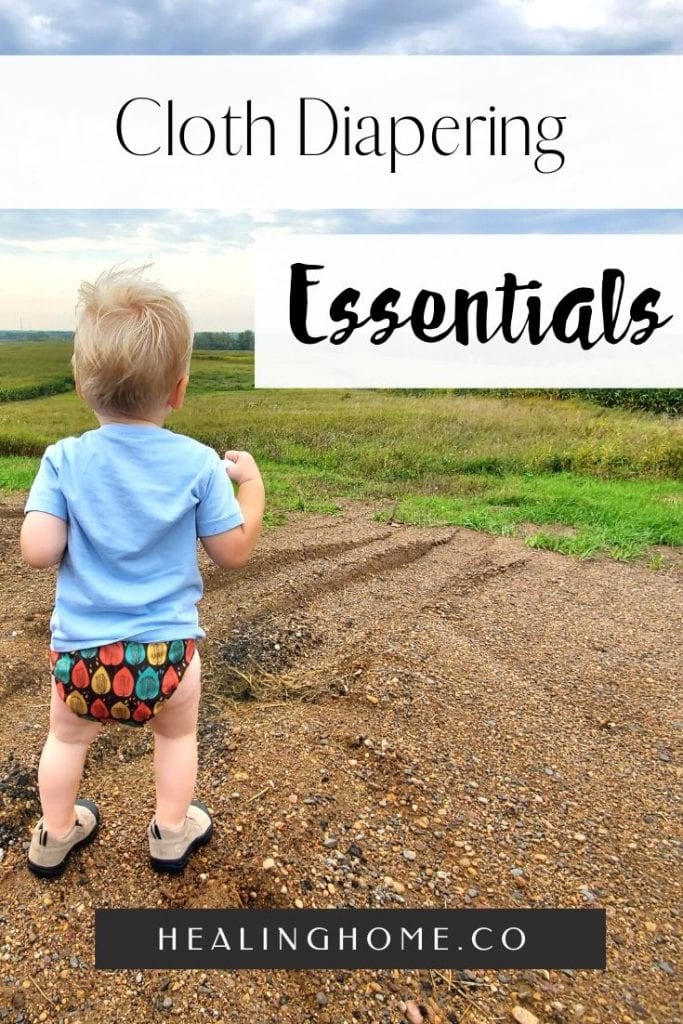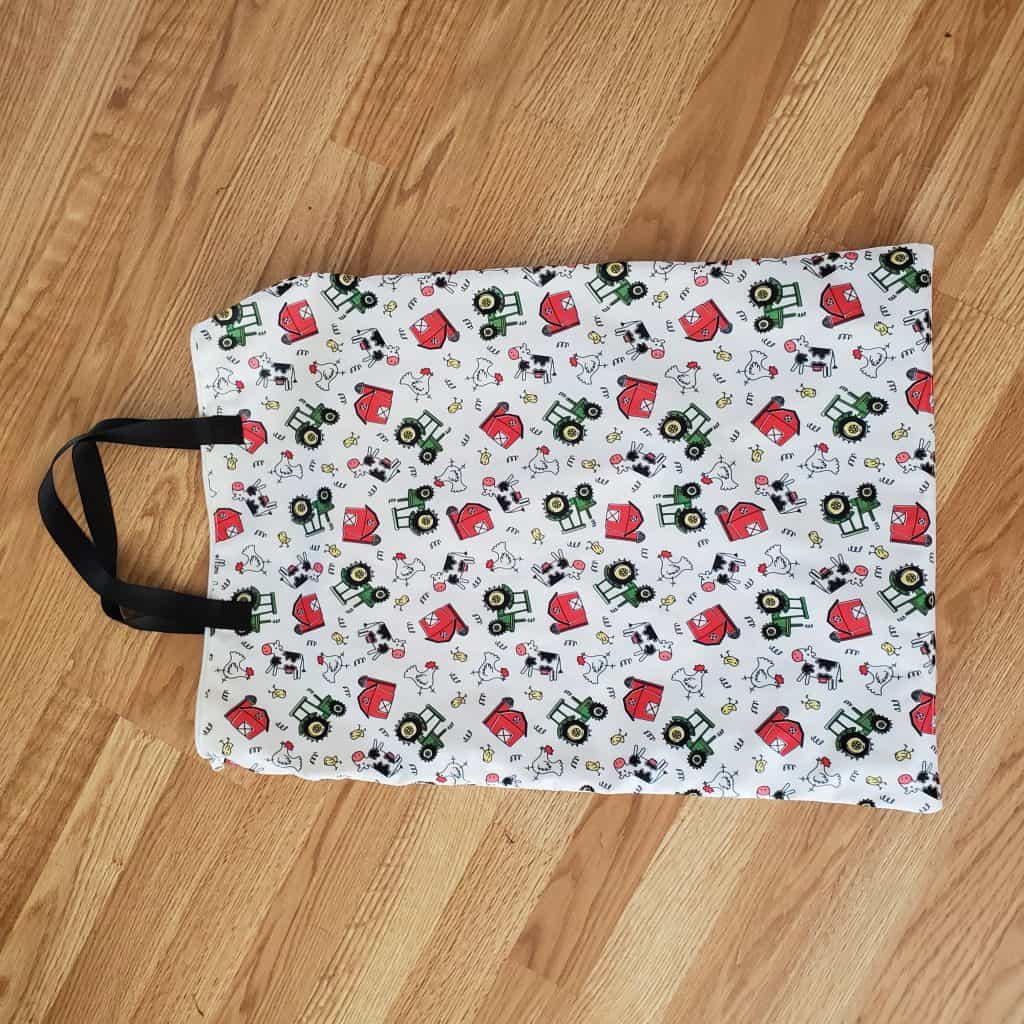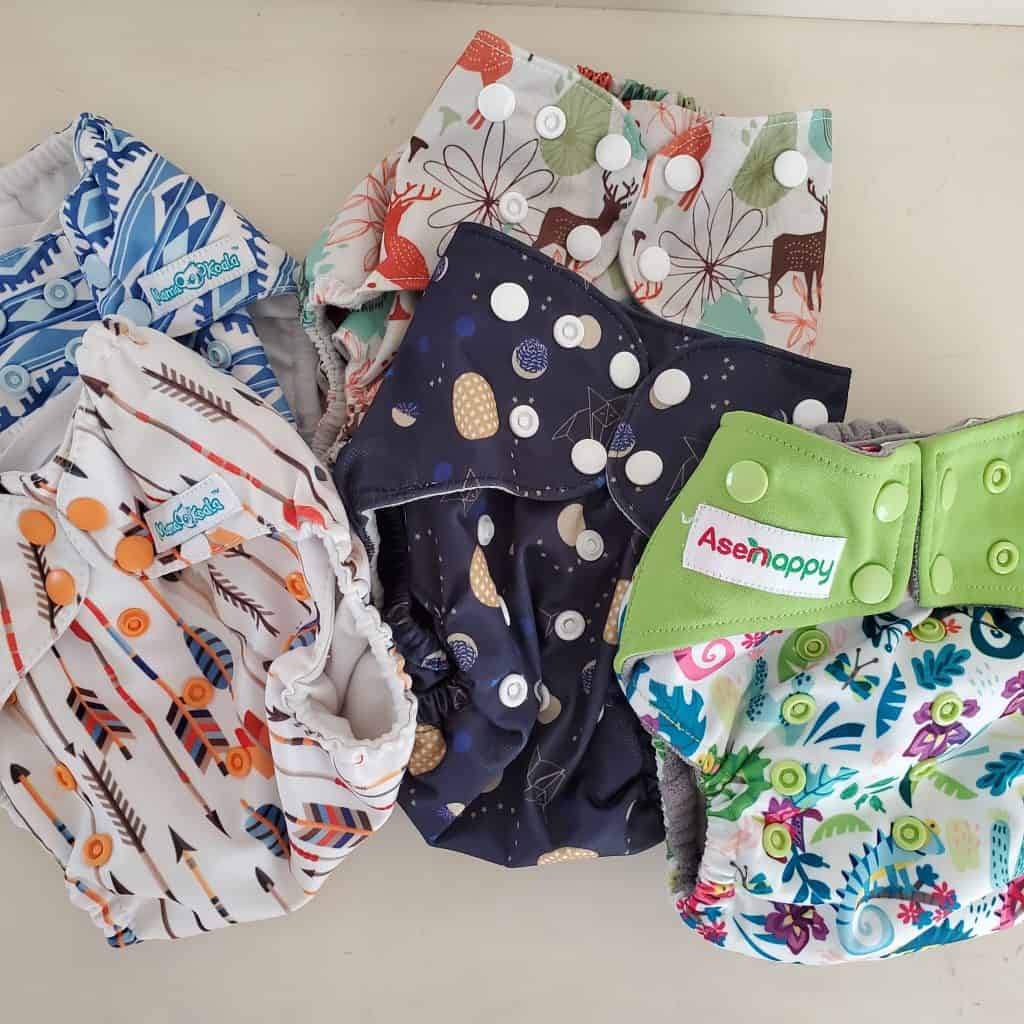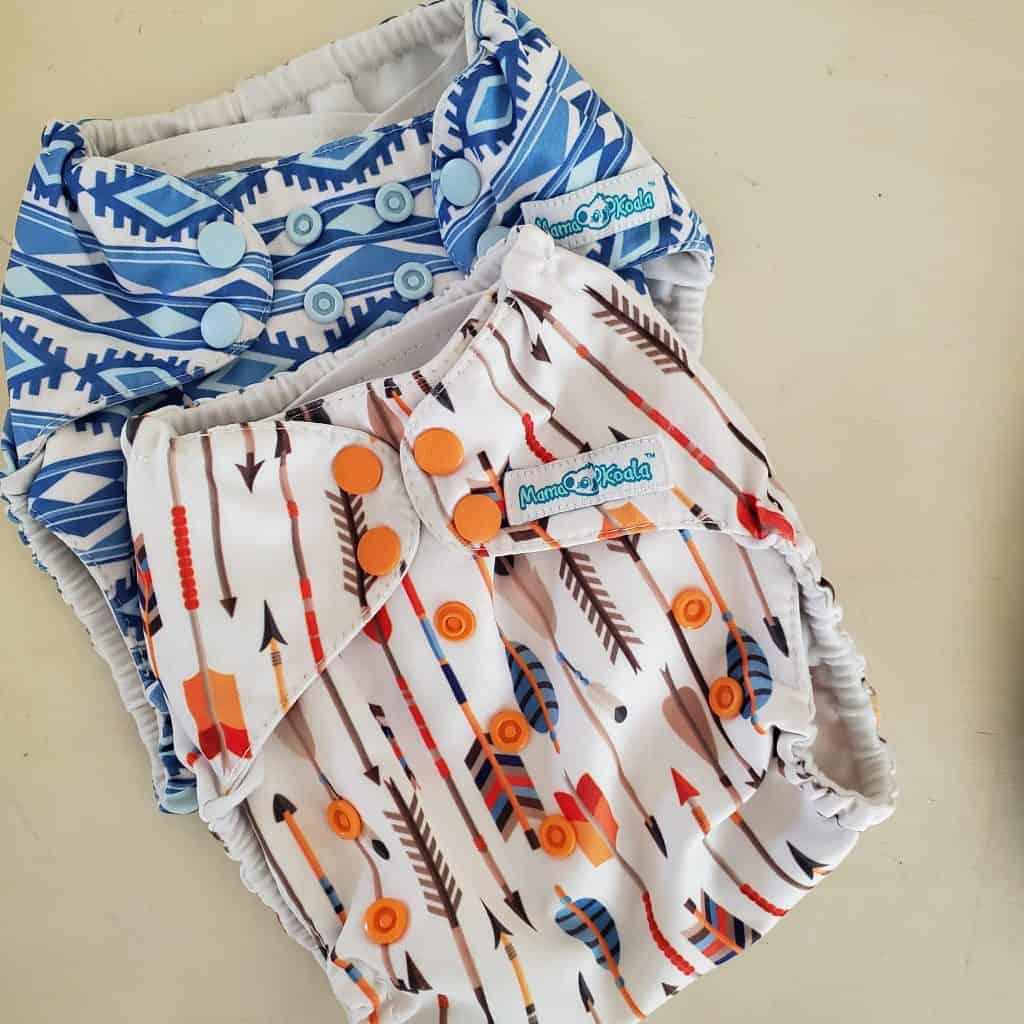When I started cloth diapering, I became a crazy researching lady! I perused the deep parts of the internet looking for all the possible information I could find on cloth diapering essentials. There is an abundance of information out there on the best essentials for cloth diapers. On our journey, I discovered something important. There is no one right way to cloth diaper. Every family is going to do it a little bit differently. These are our cloth diapering essentials.

This page may contain affiliate links. To view my full affiliate link disclosure, click here. There are Amazon affiliate links in this post. As an Amazon Associate, I make a small commission from Amazon links in this post. Find our privacy policy, terms of service, and more information about user data by visiting the links above.
What are the Advantages and Disadvantages of cloth diapers?
After 18 months of cloth diapers and the pending arrival of an addition behind to diapers, I can honestly say that I continue to love cloth diapers. Don’t get me wrong, I’m not saying it’s easy. Far from it, but I do find it worth the time and effort I put in.
I ‘survive’ all the poop, pee, and inconvenience because it’s worth it for my family.
The Top Advantages for Our Family
- It saves us money. If we were disposable diapering, I would want really high-quality diapers. Diapers that didn’t contain dioxin or bleach. I’d try to find ones that didn’t contain polypropylene (good luck on my part) and that came from an ethical company. Based on those ambitious standards I estimate that disposable diapering one child from 0-2.5 would cost us at least $2,600. Although my numbers are not exact, I estimate that for cloth diapering our first, we have spent less than $450 to date.
- We love the fluff butt patterns. There are very few things cuter than putting a new pattern on and watching those chubby thighs toddle around.
- We love not contributing to the landfills. We are not the most sustainable family; I will publicly admit that recycling has been a challenge for us. However, 3.5 billion tons of disposable diapers go into landfills each year. There is research to claim that cloth diapering between electricity, water resources, and manufacturing, is actually harsher on the environment than disposable. We personally feel like we are making an excellent choice and don’t disregard anyone that chooses to disposable diaper.
Top Disadvantages for our Family
- Experiences like this. This was one of the worst cloth diapering stories I have had to this date!
- Problems can be hard to troubleshoot. Diaper rashes in particular have been frustrating to me. In my case, our diaper rashes have been impacted by our cleaning routine. When a child is suffering from a diaper rash it can be frustrating with the long process it takes to troubleshoot the wash routine. The first thing tired is not often the reason for the problem.
- Others caring for the diapers. Making the decision to cloth diapers is between the parents of the child. However, your decision is going to impact the others who are caring for your child. Learning to get others on board with your decision and when to let go is a process of learning.
Cloth Diapering 101
New to cloth diapering and looking for resources? I’m not going to leave you hanging. I compiled some of my top-asked questions and have created a Cloth Diaper Series to answer a lot of the topped-asked questions.
- Types of Cloth Diapers Explained
- A Hard Water and Crunchy Mama Cloth Diaper Wash Routine
- How to Cloth Diaper for under $400
- Best Amazon Cloth Diapers – How to Research Cloth Diaper Companies
We Survive Because of our Cloth Diapering Essentials
I wish I could just lie and tell you that we only survive because of the convictions I listed above. It would be nice to stand on ethics alone. Yet, that would be razor sharp lie. We honestly survive because of the products that we have discovered. These cloth diapering essentials are specific to our home, routine, and convictions. Some of these products I have found are based on the recommendations of other bloggers, cloth diapers, and mommas.
When we live in a community, we find resources that help each other. These are cloth diapering essentials and we have found them helpful.
Borax

The first two products on this list are used due to our hard water issue. Our water is high in minerals, contaminants, and iron.
When you use bleach on high-iron water, you will stain your diapers. There is a highly funky chemical reaction that takes place when bleach and iron meet. It leaves a rusty orange stain on fabrics. Although I have never tried this, I’ve seen enough pictures to know that bleach was not going to be in our cloth diaper routine.
Borax is a lovely alternative to use add to our wash routine that combats iron, aids in detoxifying, cleaning, and sanitizing our diapers.
Borax is also a simple compound called Sodium Boron. Borax and Boric Acid are both related compounds to Sodium Boron. To put it simply, Borax is basically the salt of Boric Acid. Sound confusing? Let’s boil it down even more simply.
Sodium Boron is basically a naturally occurring compound found on the evaporated deposits produced by evaporated seasonal bodies of water.
I personally chose it as a resource because of its natural state and its ability to clean so dramatically.
Simply a 1/4 cup of borax added to every diaper cycle helps clean and detoxify my diapers.
Hydro-Peroxide

Hydro-peroxide is a little miracle solution that hides in most home closets. I specifically use it when I feel like my diapers are getting too ‘stinky’, ‘dirty’, or are just in need of deep cleaning.
Would you believe me if I told you that Hydro-Peroxide is about 85% as effective as bleach as a disinfectant? Here is an excellent article that explains why Hydro-Peroxide is effective.
Both Borax and Hydo-Peroxide can be used as a stripping or deep cleaning solution for cloth diapers instead of using bleach. I strip my diapers using this method. However, because I have health convictions about Calgon, I eliminate this from the routine and instead focus on the Borax and Hydro-Peroxide.

Large Diaper Bags


When we first started cloth diapering, I had this silly idea that I could use the small wet/dry bags that came with the cloth diapers I had purchased on amazon. These are only about 12 in x 12 in and they fill up within about 3-4 diapers. Which is great when you are out and about, but awful when you are trying to pack in 3 days’ worth of diapers! Soon diapers spilled out over the bags hung in the nursery and the stench was quite ‘stenchy’!
However, most of the giant diaper bags that I saw were quite expensive, usually upwards of $30. Which was not something friendly to our budget.
I started to dive deeply into the reserves of amazon. One link led to another, which led to another, and soon I was out of the ever-present ‘sponsored’ ads of amazon. This led me to a company that offered an affordable larger Wet/Dry bag for only $12.99. We now have two of these large wonders, which is nice to alternate.

The Best Amazon Cloth Diapers



In previous editions of my cloth diaper series, I have talked about cloth diapering for under $400, the best amazon cloth diapers, and how to research amazon cloth diaper companies. Therefore, I won’t beat my opinion on amazon cloth diapers/China cheapies too hard. There are ways to utilize cheaper diapers and still buy quality. This has saved our budget and our sanity as we have investigated hundreds of diaper companies. Our favorites continue to be Mama Koala, Asenappy, and Simple Being.
Researching cloth diaper companies on amazon can be tough, but here are the three guidelines I look for:
- Does the company have a website?
- Does the company have a positive social media presence?
- Does the company reply to your messages or attempt to connect?


Cloth Diaper Essentials Safe Butt Cream
As young parents, we were given lots of advice on diaper cream when our little, tiny baby got a nice butt rash. Everyone had a miracle salve to put on that would take care of the problem. We made the mistake of going against our better judgment and trying a couple. The problem is that with cloth diapering you cannot use creams that have certain ingredients or they will leave a residue on your cloth diapers. The main culprit is zinc and petroleum.
Goodness gracious, sake’s alive (as certain relatives I have would say) zinc bit us in the booty. Although the ‘miracle’ diaper creams helped our son, we were left with dozens of diapers with residue caked into our fabrics.
Thankfully, we have learned a few things along the way, and I can confidently say, these are a couple of cloth diaper-safe butt creams that we can’t live without.

Boudreaux’s Butt Paste continues to be our favorite as it seems to really help our baby’s bum.
Another great option is Burt’s Bees Multi-purpose ointment I like this stuff when there is a specific spot on my baby’s bum that needs a little extra love and attention.

Charcoal Diaper Inserts

The number one reason I like charcoal inserts/diapers is that they don’t show as much stain, but as a close second, they also absorb more liquids. It takes a few washes to truly see the potential in these little marvels, but they are much more absorbent than microfiber inserts. Layer a couple of these bad boys in an overnight diaper and your child wakes up dry and refreshed.

Is Cloth Diapering Worth it?
For us, cloth diapering is totally worth it. The cloth diapering essentials we use save our sanity and make it doable for our family. We save money, enjoy the process, and love watching our littles run around with a fluffly little behind. It’s just too cute! How about you, is cloth diapering worth it for you?
